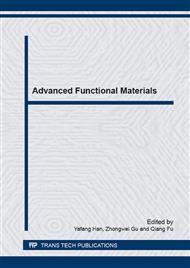p.109
p.115
p.125
p.129
p.135
p.141
p.149
p.154
p.159
Ferroelectric and Photovoltaic Properties of Mn-Doped Bismuth Ferrite Thin Films
Abstract:
Bismuth ferrite is an important material in ferroelectric photovoltaic field, because of its narrow band gap and large polarization. Doping is a common method to further improve the photovoltaic properties of bismuth ferrite. Mn-doped bismuth ferrite thin films were prepared by sol-gel method. The effects of manganese on the crystal structure, ferroelectric and photovoltaic properties have been investigated. The result indicates that Mn-doped bismuth ferrite thin films are single phase and the lattice constant increases with the increase of manganese content. As manganese content increases, the remnant polarization and coercive electric field increase, while the short circuit photocurrent density and power conversion efficiency decrease. The open circuit photovoltage increases first and reaches the maximum and then decreases as manganese content increases. The results indicate that enhanced ferroelectricity caused by addition of manganese doesn’t make improvement on the photovoltaic characteristic.
Info:
Periodical:
Pages:
135-140
Citation:
Online since:
March 2015
Authors:
Keywords:
Price:
Сopyright:
© 2015 Trans Tech Publications Ltd. All Rights Reserved
Share:
Citation:


